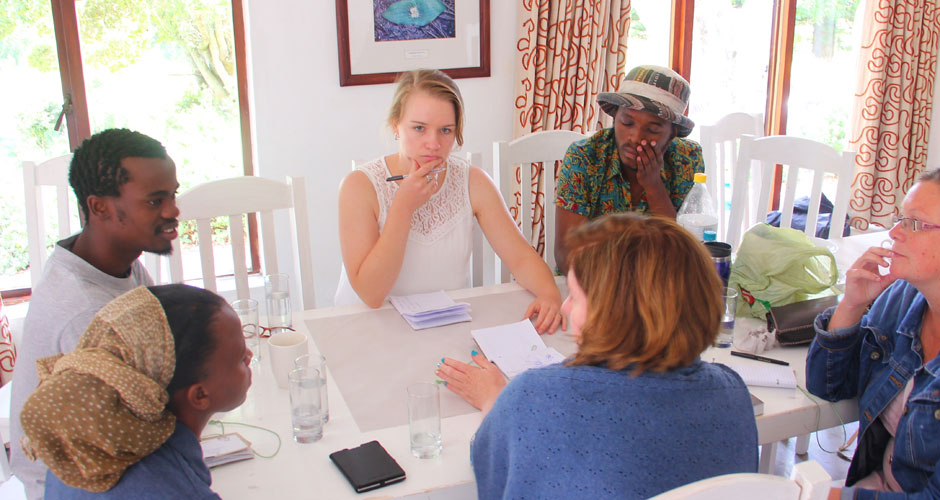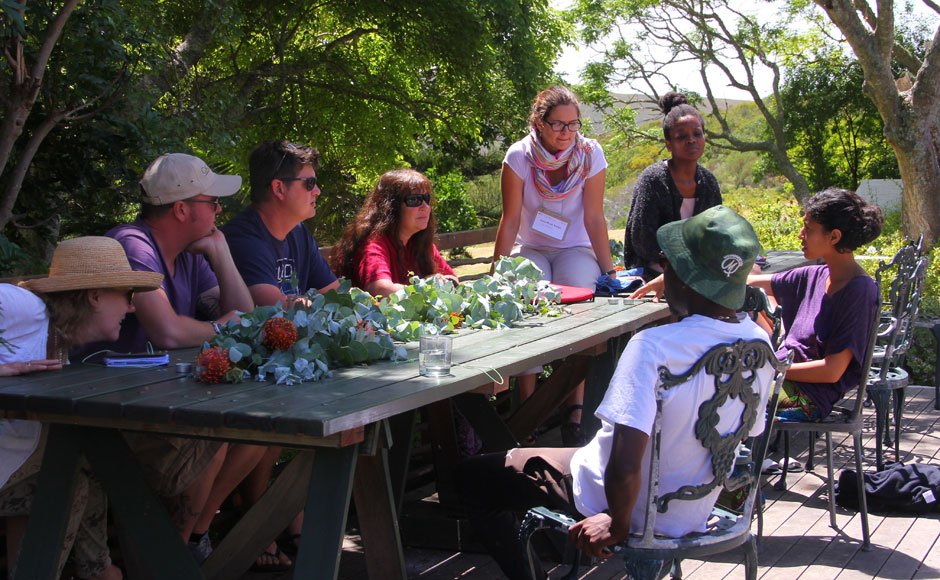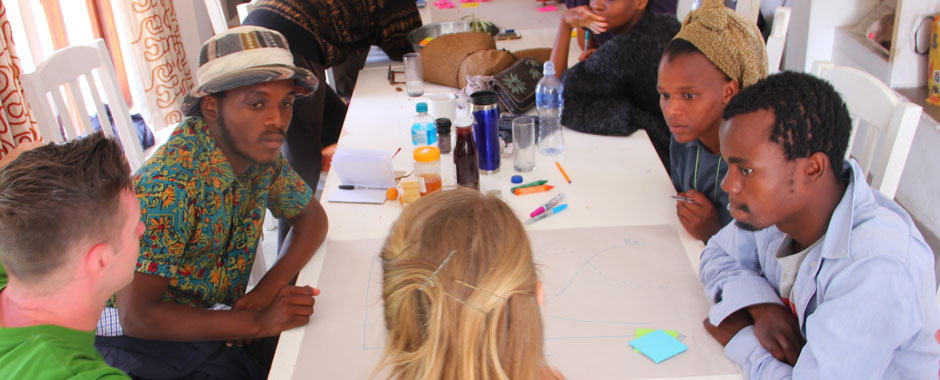In this blog post, Laura Pereira explains the idea of a ‘Transformation Lab’ (T-lab). T-labs are being used in our Pathways Network project in 6 countries to try to enable socio-ecological transformations. In the post, Laura uses an example of a completed T-lab from the GRAID research project in South Africa.
For a short summary of T-labs, view a slideshow prepared by Laura and Per Olsson of the Stockholm Resilience Centre.
As part of our GRAID research project, the food team at the Centre for Complex Systems in Transition (CST) convened two T-labs (Transformation Labs) designed to interrogate and strengthen an alternative food system in the Western Cape, South Africa. The first was held at Grootbos Nature Reserve from 27-30 November 2016 and the second at Nine Oaks in Paarl 19-21 July 2017.
As we are now writing a report and feeding back to the participants who have dedicated a substantial amount of time to this process, it seems a poignant time to offer some reflections on T-labs as a process and, in particular, on the challenges of convening ‘safe’ spaces for immersion in wicked problems.
What is a T-lab?
The term ‘T-lab’ has only recently come into use, but it builds on the methods and approaches outlined in the 2015 Social Innovation Lab Guide (SILG). ‘Labs’, in this context, bring together diverse groups of people working on complex challenges to see the system differently, redefine problems and identify opportunities for innovations to make a difference. T-labs particularly work at the meeting points and conflicts of social and ecological change.
T-labs have been held around the ‘Transformations’ conference organised by the Stockholm Resilience Centre in 2015, and SDG-focused ones are being organised in the run-up to the Resilience 2017 conference.
They’re also a central part of the ISSC-funded Pathways Network project run by the STEPS Global Consortium, which is running T-Lab processes in 6 sites around the world (India, Argentina, China, Kenya and Mexico) in 2016-2018.
Addressing food in South Africa
Why are discussions about the food system in South Africa so challenging? While the topic is complex and difficult, it is also a matter of life and death. Not only is one dealing with a complex social-ecological system comprising many diverse actors and logistics that spread across time and space; for food in South Africa, the outcome of ‘success’ is the provision of a basic need/human right.

I have written elsewhere on the state of the South African food system, but needless to say, in the South African context it is impossible – and in fact irresponsible – not to engage with the legacy of apartheid, race, inequality, land, and even culture. Convening a T-lab on the South African food system is therefore not a straightforward process and requires constant re-adjustment. Here, I offer some insights into the process.
Process, process, process
The core design principles of a T-lab emerge from a re-configuration of the Social Innovation Lab Guide. The SILG’s authors warn that social innovation labs are not appropriate for every instance of addressing a complex challenge; similarly, it is important to understand when a T-lab can be useful or not. However, as T-labs are a new and experimental concept, especially in non-Western contexts, it comes down to the convenors (in this instance, us as academics) to make the call and to design a process accordingly.
To put it simply, three core principles are essential to a T-lab:
- the challenge being addressed by the group must be complex and preferably social-ecological in nature
- the convened group should be diverse (how diverse is a still up for debate), and
- there should be an action-oriented outcome to the process that leaves participants energised to drive change.
With these principles in mind, our first T-lab convened a group of ‘change-makers’ that was diverse, but did not represent the ‘whole system’: we believed that it was important for participants to feel safe and to build trust amongst themselves, so they needed to have some values and views in common.
The T-lab in South Africa
We decided to focus on two questions:
- What is the viability of linking alternative food actors into the mainstream without losing the integrity that makes them small-scale/alternative?
- How do we build relationships that enable alternative food systems to grow?
To address these questions, we convened a group who we felt were part of, and committed to, creating an alternative to the prevailing food system – focussing on issues of sustainability, equity and health.
What emerged was a programme where participants engaged in a series of processes, starting with a learning journey on the Sunday, en route to the venue, where they were asked to observe the food system around them and to feed back their reflections that evening. As there was a strong focus on indigenous foods, the group took a field trip to explore the nature reserve where we were staying. Everyone was quite taken aback by the prevalence of edibles in the fynbos landscape that we later cooked up for our meals.
The talk by a visiting Swedish academic on the global food system provoked some interesting discussions; afterwards, participants were asked to team up to create an artefact depicting what their vision of a positive food system would be, using material around them. This was probably the most energetic process and the energy levels of the group definitely soared during this creative process.

As well as some other personal reflections and group discussions, in the final session we asked participants to list some action points that they would take on after the T-lab.
Working with contestation and difference
As facilitators we did not feel in advance that the process was too highly structured. But feedback from participants during the T-lab had us constantly restructuring sessions so as to try and give participants some freedom.
There were concerns raised about the T-lab being a ‘Western concept’ and that the facilitators were unaware of the nuances of the South African food system. This was partly a reaction to a facilitation team who had not previously worked together, but it was also a result of us using an experimental process. We needed to learn at an exponential rate about how to hold the space to allow for an emergent outcome that was driven by the participants themselves – but that at least would yield some sort of outcome. Whilst ‘failure’ is not really something that I believe can happen in an open process, it was often at the forefront of my mind as issues around race, power dynamics, cultural backgrounds and trust raised their heads at different points.
New alliances

However, while these contestations were taking place, new relationships were also being formed and networks were being built. There are demonstrable examples of this both articulated by participants, but also showcased through subsequent collaborations. During the work, the participants formed relationships. One participant had this to say:
I was encouraged that I am not alone – there are a lot more people longing for the food revolution to take place. At times, I am tempted to quit and do something else that will make me more money. (But) they motivated me to continue farming to do something about the country/environment.
After (the T-lab), I started working with an indigenous food innovator and activist on an indigenous garden at the Institute, and with some urban farmers to erect community gardens in a nearby community centre.
From these relations, participants planned to collaborate on their work. For example, the chefs from a well-known restaurant planned to work together with the local food innovator to incorporate local menu at the Hotel’s restaurant. An artisan baker promised to build an oven at a community garden in an informal settlement. The latter has been a huge success in growing the community garden as a space for innovation and education about agro-ecological farming, nutrition and the importance of healthy diets in the community.
The respondents also realised the importance of sharing. They recognised that they have something valuable to share from their personal experience and what they had learned at the workshop. Quotes from three participants are below:
“Share what I have learned with as many people as possible”
“I can give a tour of our wine estate to anyone who is willing”
“A researcher could help with giving children tour guides so that they can learn about biodiversity”
There was also an interest to try new food. For example, the respondents were excited about using wild fynbos in their diet as they had seen it being used in the meals that were prepared. One participant had this to say:
“I will incorporate more indigenous and local foods into my diet, and grow some medicinal plants.”
The participants also committed to reduce food waste. One participant promised to process surplus food into consumables. There was a recognition of other ways of doing things:
“I normally target high-end customers, but maybe I can give some of my excess vegetables to the Food bank and to the school children of the institution I work at instead of wasting it.”
Coming to terms with uncomfortable issues
Although at many points I had a sense that the process was running away from us, in retrospect the ups and downs of how the T-lab eventually played out was an important learning curve on this journey of thinking about sustainability transformations. Coming to terms with discomfort is essential, not only for participants, but maybe more importantly for the facilitators too. Participants will keep you on your toes, ugly issues will come up and will need to be acknowledged, not everyone will be happy and comfortable doing everything you ask – and this is actually okay.

There is an adage to ‘trust the process,’ but in such an experimental process this can be very hard to do. It is more important to trust yourself and also to know that you have a strong team to back you up. Facilitating a T-lab cannot be a 1-(wo)man show: it is imperative to have a team.
‘Chopping and chatting’
So despite the contentious moments in the structured part of the T-lab, how did it all come right in the end?
It is critical to remember that when designing a process – whether it’s a small workshop, or a large conference – the informal interaction sessions are as important, if not more so, than the carefully engineered programme of events. This was definitely the saving grace of the first T-lab.
As all 30-odd of us were staying at the same self-catering venue in the middle of a nature reserve, we cooked our own meals. There was also a dam for swimming nearby, a large patch of grass, a pool table and a reserve in which to wander. Whilst having spaces for relaxing was important, in my opinion the key connections were made when everyone was tasked with helping to prepare food. As the T-lab was about the food system, eating healthy (sometimes even hyper-local indigenous food from our forage field trip) and preparing it together enabled the participants to engage with each other on a human level through the shared experience of ‘chopping and chatting’. As we had a bunch of chefs in attendance, on the second evening we held a ‘cook off’ where chefs had different teams of sous-chefs to help them each to prepare a different dish. It was Masterchef, T-lab style, and it worked – it really worked.

Preparing and sharing a meal together was the best kind of bonding that brought everyone together, despite sometimes fractious encounters. It allowed me to trust in the process, as well as in the team. Whilst the T-lab was not all I had envisioned it to be, it probably ended up being something more important – a learning to take into the next iteration.
Ending with Movements
T-lab 2, held 8 months later, was a completely different experience for me. Whilst we had about 60% of the participants from the previous lab (they came back!), there were also some new faces that had been invited at the request of participants. We had also previously consulted some of the T-lab 1 participants in setting up the next phase.
This time, we only took 2 days and 2 nights and convened the event closer to home. The design was left completely up to me and my colleague Scott Drimie. Instead of an agenda, we developed three ‘movements’ to the process: sensing the system (what is it that we want to change; what does transformation mean), letting go (personal reflection- why do I do what I do, what is holding me back) and letting come (now what, what needs to happen to drive forward the change I want to see).
Whilst there was structure, there was no set agenda other than to create a space for connections to happen and synergies to emerge. Many of the group knew each other from before, so it was important to make the newcomers feel included, but this was a surprisingly easy thing to do due to the openness of the design.
We still had a provocative talk from an academic and there was still an opportunity for everyone to get creative with materials to build an artefact, but the process seemed to flow much more easily. It was exactly like the movements in a piece of music: distinct, yet connected. And, of course, we also prepared our food together, lit a fire and danced around the braai.
The reflections from the participants on this process were truly positive and so I believe that somehow we got it right. By listening to feedback, actively responding and being open about the process, I believe that we were able to create a space for true engagement and trust-building.
“My experience was good. I think this workshop was powerful. Compared to other workshops which were structured from the top to the bottom. But this time we could feel that things were starting at the roots.”
According to the participants, the bottom-up approach allowed for people to open up and think, as explained by this participant:
“This space is necessary and effective in its laid-back nature as it allows people to open up and think slowly. It was both fluid and productive.”
The second theme that emerged from the reflections was the opportunity to share diverse opinions. According to the participants, the diversity of the participant’s area of expertise and race was important for the realization of what can be done differently in the food system for different population groups. For some of the participants, the diversity provided answers to questions, a space to influence the influencers and to create active citizens. As one workshop participant put it:
“It was my first experience at a T-lab. It was useful and constructive: the networks and collaborations especially. I got diverse opinions and the missing links were filled.”
“What we are dealing with is far more complex than I thought it was.”
The T-Lab was also beneficial for networking people in the alternative food system. The participants noticed that each of them was involved in the food system, but in their silos. The T-lab provided a bridge to connect these alternative food vendors. As this participant remarks:
“It was great to meet with people from the same industry and with the same stories.”
The participants also mentioned that the T-Lab gave them encouragement and recognition. The creation of a common group of alternative food vendors enhanced the participant’s sense that they are not alone.
“The T-Lab has given us a recognition that we don’t receive from others because we are challenging them on fundamental issues that they are unlikely to embrace. I think this recognition is great.”
Not everything was perfect. There were definite moments of discomfort, but I hope I am getting used to acknowledging these as moments that need to happen, and that my role is to guide people into the space beyond.
I am excited to see how the commitments that everyone made at the end of the T-lab are taken forward and what new actions emerge. And whilst it’s unlikely that we will be able to convince funders to allow us to take teams of stakeholders away just to cook and eat together, I feel at least that I’m learning how to read and adjust to complex facilitated processes – the foundation of creating a ‘transformative space.’
I hope these experiences can inform the T-labs that we run as part of the Pathways Network, as well as other experiments with addressing complex social-ecological challenges in different settings around the world.
About the author
Dr Laura Pereira is part of the PATHWAYS Network project which runs a series of T-Labs around the world exploring pathways to sustainability. She is based at the Centre for Complex Systems in Transition at the University of Stellenbosch, South Africa.
View a summary slideshow about T-labs (Slideshare.net) or find out more about the PATHWAYS Network.
